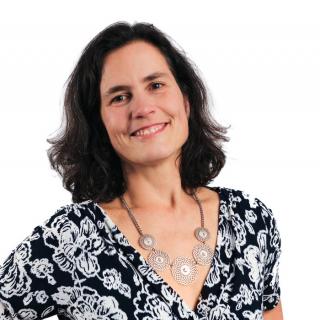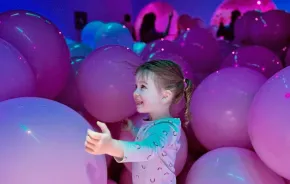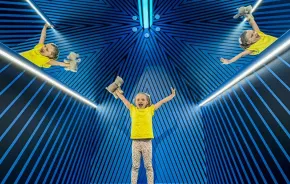 Studio East's new production, I Never Saw Another Butterfly, is a play about a tragic, but ultimately hopeful, story: The children of Terezin, a Holocaust concentration camp, who, with the help of an extraordinary teacher, created art and poetry that survived them and continues to tell their story today.
Studio East's new production, I Never Saw Another Butterfly, is a play about a tragic, but ultimately hopeful, story: The children of Terezin, a Holocaust concentration camp, who, with the help of an extraordinary teacher, created art and poetry that survived them and continues to tell their story today.
Artistic director Lani Brockman gave us some insight into the history of the play and how parents might prepare kids for the subject matter. (Find more information about the production and buy tickets at Studio East's website.)
1. What is the background of the play?
I Never Saw Another Butterfly is a true story about the children in Terezin, a concentration camp north of Prague during WW2. The children had a teacher who encouraged them to draw, write, sing and play. She believed art would help them deal with what they were going through, and hopefully, give them the strength to go on. The poetry, pictures and stories the children wrote were buried in suitcases and discovered many years following the war. Of the 10,000 children that went through Terezin, less than 100 survived. This play is a tribute to their strength and perseverance. We use slides of their artwork to help tell the story.
Susan Bardsley, who writes the music for StoryBook Theater [a branch of Studio East that produces interactive musicals for ages 3-10] received permission to put music to five of the poems, and they are sung by some of the cast members. The play is a sensitive story of love, hope and survival and will include youth, ages 8-18 as well as a few adults. My purpose in doing this play, and I have directed it three other times, is that anyone involved will remember the Holocaust and be one of the many who never allow it to happen again.
2. How can parents prepare kids for this tragic story? How can they follow up?
It’s best for parents to have a dialogue with the children they are bringing to the play before and after so that they are prepared to see a production that will likely invoke some sad emotions. Parents may want to discuss some of the terminology of the time period, such as concentration camp or anti-Semitism. Our student cast members have also prepared research about this time period, which will be displayed in the lobby.
3. What’s an appropriate age to take kids to this production? What might kids learn/experience from it?
We recommend ages 9 and up for this production. Seeing other young people like themselves, portraying children that were part of the tragedy of the Holocaust, will likely deepen their understanding of it and make it easier for them to empathize with what these children went through. They will also come away with some specific facts and impressions about the Holocaust and the stories of these particular children incarcerated at Terezin.
4. What are you most excited about in terms of this particular production?
I am most excited about how much these young cast members have risked to feel and communicate this material. As actors in this beautiful story, our children get an opportunity to be the voices for these children. Thankfully, none of them experienced the horrors of the Holocaust, but all of them have explored what it means to be treated unfairly, bullied or separated from loved ones. I am so proud of their commitment to the material and their willingness to learn about this horrendous time.
5. Anything else you want to say about this show or Studio East’s upcoming season?
No history book or video can possibly bring these children to life again … but through the immediacy of live theater, our young actors can bring us history as a living, breathing world, peopled with children very much like themselves; children from privileged backgrounds, from loving families, plunged into terrifying situations that we can barely imagine today. Yet we must imagine and we must be reminded, for history forgotten repeats itself.
Theater ... does not always entertain, but it enriches our lives, deepens our understanding; as performers, as audience members, and as teachers.
6. Beyond this particular production, why should parents take their kids to the theater?
Theater is a fabulous way to connect to life! Theater is live. It is real people telling a story right now. It gives children the opportunity to learn life lessons and recognize situations or experiences they’ve had through the observation of others. Often times when we watch a play or musical, we identify with the story, characters, songs and dialogue.
I love Participation Theater, where children are asked for their opinion and asked to contribute to the story on stage. Participation Theater for young audiences is a great way to introduce children to theater as they are welcomed and applauded for their contributions. When a child sees their input make a difference on stage, it validates them and opens their minds to creative thoughts and imagination.
7. What are some ways that children’s theater changed in the past decade? What are some new trends to watch out for?
Theater has taken beautiful advantage of the world of technology. Today we see stages with projections incorporated into the set design and any number of special lighting and sound effects. On the non-technical side of things, I believe theater continues to grow in accessibility. Today’s parents realize the many values theater offers children – that the life skills one gains make a difference to the whole child, not just the performer.
If you go ...
When: I Never Saw Another Butterfly runs at Studio East through Saturday, Oct. 13. Remaining performances are Sunday, Oct. 7, 11 a.m. and 2:30 p.m.; Friday, Oct. 12, at 7:30 p.m. and Saturday, Oct. 13, at 2:30 p.m. and 7:30 p.m.
Tickets: Tickets are $14; purchase them online. The play is recommended for ages nine and up.
Where: Studio East Mainstage Theater, 11730 118th Ave N.E., Kirkland.











